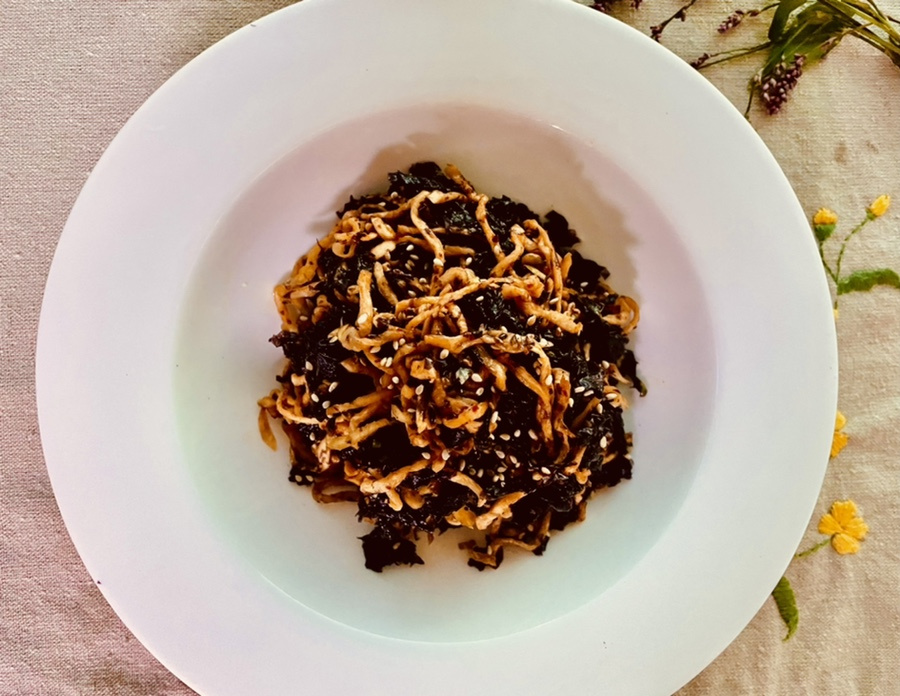Thinly Sliced Dried Radish and Gim (Seaweed) Salad
How to Make Thinly Sliced Dried Radish and Gim (Seaweed) Salad

I’ve dried thinly sliced radishes until they’re crisp, creating a unique type of ‘muchim’ (seasoned salad). These radishes are cut for ‘musaengchae’ (fresh radish salad), resulting in a finer texture than typical ‘myeolchi muchim’ (dried anchovy salad). This finer texture offers its own charm. Instead of perilla leaves, I’ve used roasted dried gim (seaweed) to mix in. The sweet radish and the savory ‘gopchang gim’ (a type of wide, curly laver) complement each other beautifully. This dish is a delightful side that pairs perfectly with rice.
Ingredients- Thinly sliced dried radish (homemade) 2 handfuls
- Gopchang gim (curly laver seaweed) 7 sheets
- Soy sauce 2 Tbsp
- Red crab soy sauce or low-sodium soy sauce 2 Tbsp
- Gochugaru (Korean chili flakes) 1 Tbsp
- Mirin (or cooking wine) 1 Tbsp
- Oligosaccharide (or corn syrup) 3 Tbsp
- Minced garlic 1 Tbsp
- Minced green onion 1 Tbsp
- Sesame oil 1 Tbsp
- Toasted sesame seeds 1 Tbsp
Cooking Instructions
Step 1
First, prepare the radish. Slice it thinly into strips, similar to how you would for ‘musaengchae’ (fresh radish salad). Spread the sliced radishes on a drying rack, making sure they don’t overlap. Dry them in direct sunlight or a well-ventilated area. If the weather is dry, like in winter, they should dry thoroughly in about 3-4 days when left indoors. (If you are using pre-made, thinly sliced dried radish, you can skip this step).

Step 2
Rinse the dried radish strips and soak them in cold water for about 10 minutes to soften them. While regular dried radish (muchim-yong) is usually soaked for 20 minutes, these thinly sliced ones only need half that time because they are finer. Be careful not to soak them for too long, or they might become mushy.

Step 3
Squeeze the water out of the rehydrated radish strips with your hands. Aim to leave about 20% of the moisture in the radish. This remaining moisture is crucial; it helps the seasonings adhere better when you mix in the seaweed later, ensuring a tender and well-seasoned result.

Step 4
Place the squeezed radish into a mixing bowl. Add the soy sauce (2 Tbsp) and oligosaccharide (3 Tbsp) first. Gently tossing them together at this stage helps the seasoning penetrate the radish more effectively.

Step 5
Gently mix the radish and the initial seasonings with your hands, like you’re massaging it. Let it sit for about 10 minutes to allow the flavors to meld. During this time, the natural sweetness of the radish will harmonize with the savory soy sauce.

Step 6
Now, let’s prepare the gim (seaweed). Heat a dry pan over medium-low heat. Roast the gim sheets for a short time on each side until they become fragrant and slightly crisp. Watch carefully to prevent burning. The goal is a light, toasty crispness.

Step 7
Once the gim is roasted, let it cool slightly. Then, tear it into bite-sized pieces, about 2-3 cm each. Handle the gim gently to avoid crumbling it completely.

Step 8
Finally, add the remaining seasoning ingredients to the radish (red crab soy sauce or low-sodium soy sauce, gochugaru, mirin, minced garlic, minced green onion, sesame oil, and sesame seeds). Then, add the torn gim pieces. It’s best to add the gim in batches. Mix gently after adding each portion. This allows you to control how much the gim softens and ensures the seasoning is evenly distributed throughout both the radish and the seaweed. Continue adding and mixing until all the gim and radish are well combined and coated in seasoning. This delicious side dish can be enjoyed immediately or chilled in the refrigerator for an even richer flavor.



